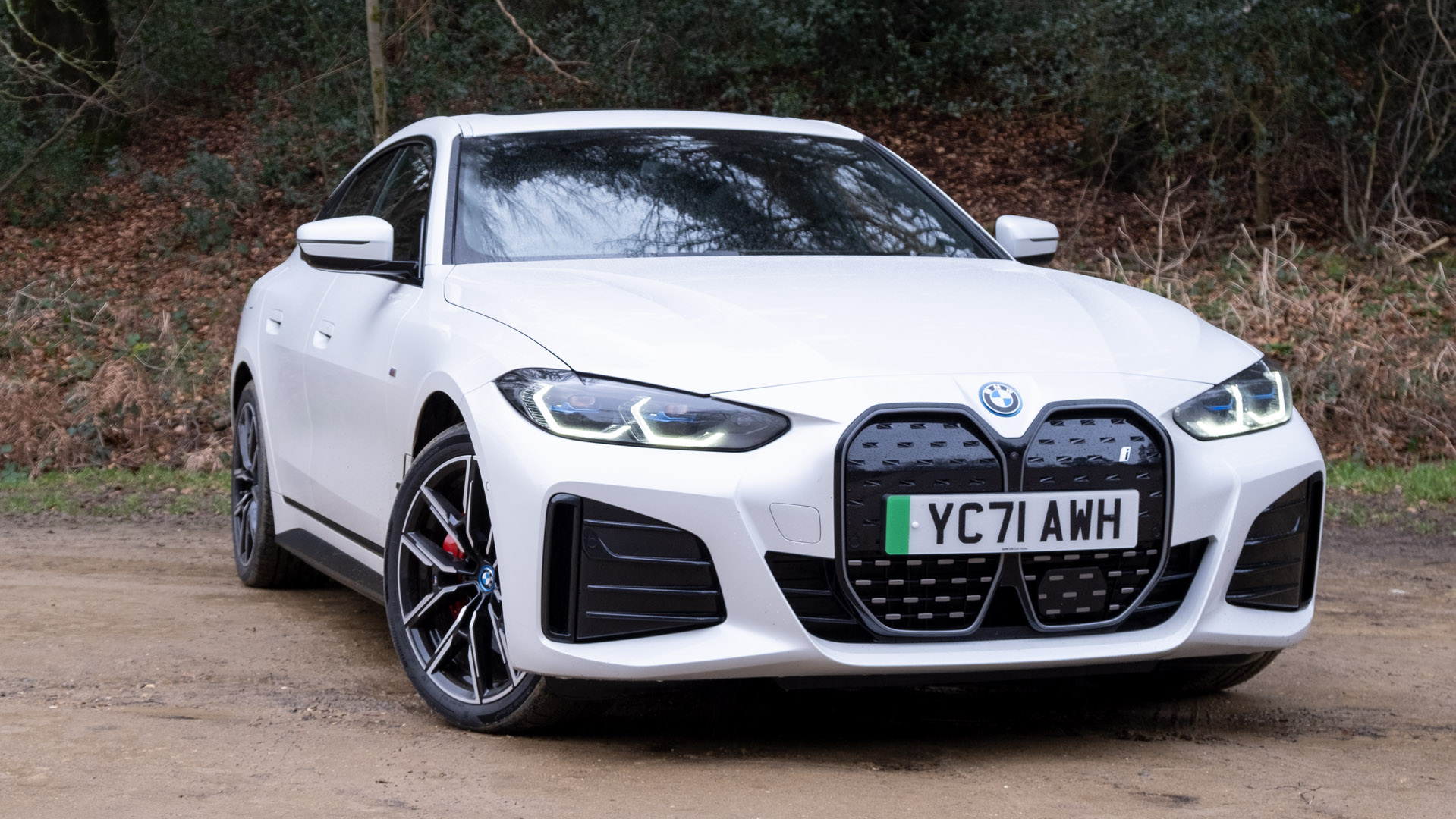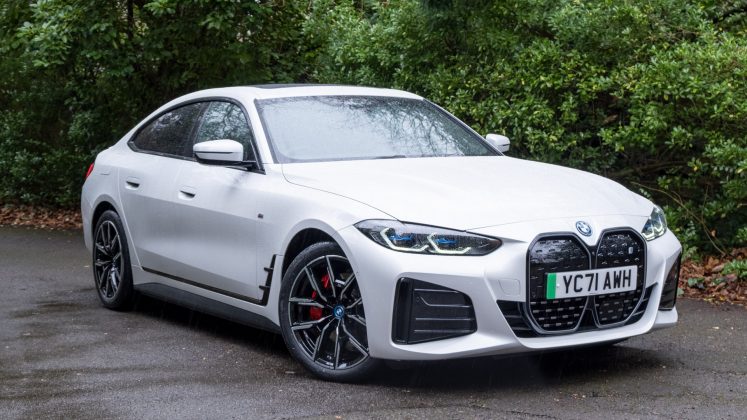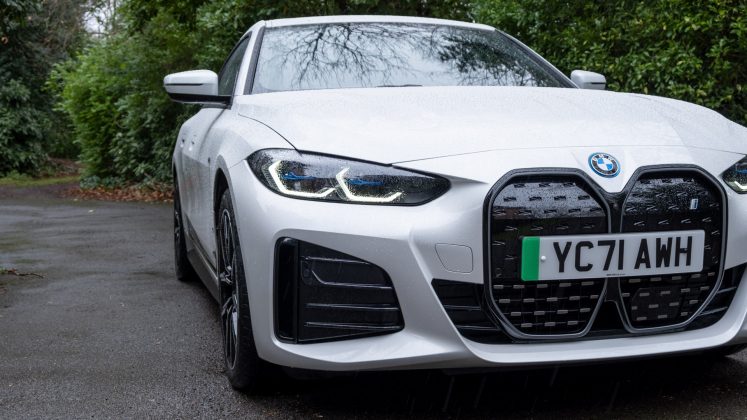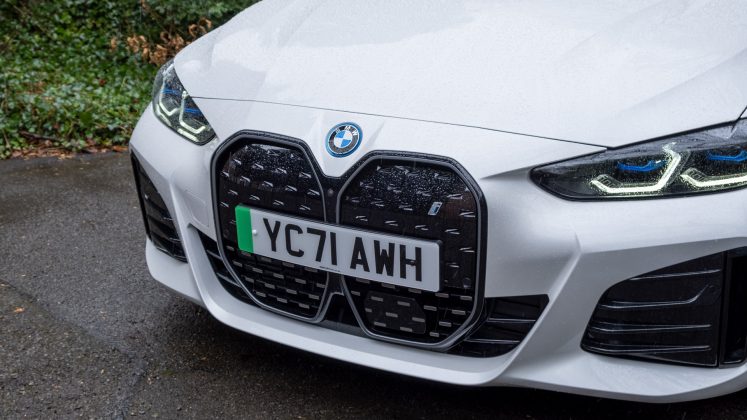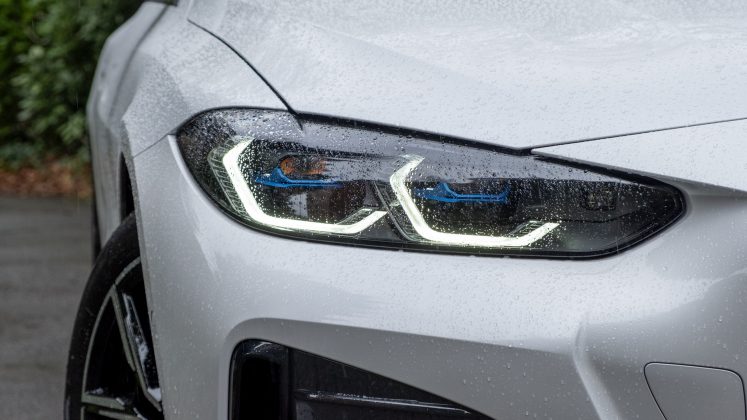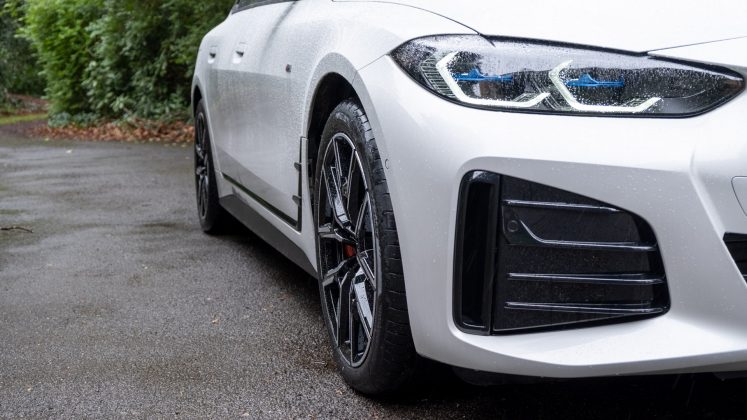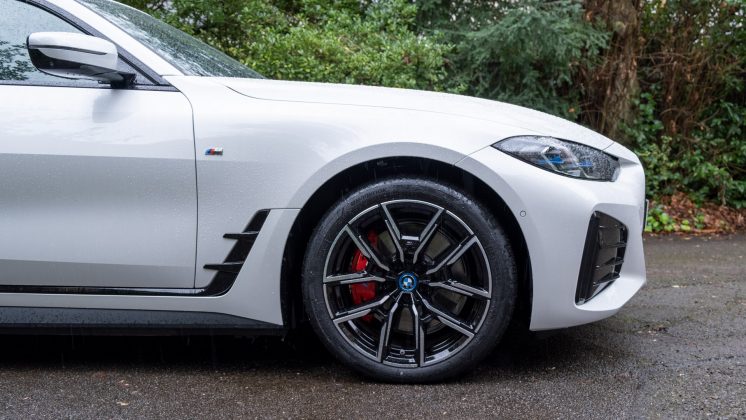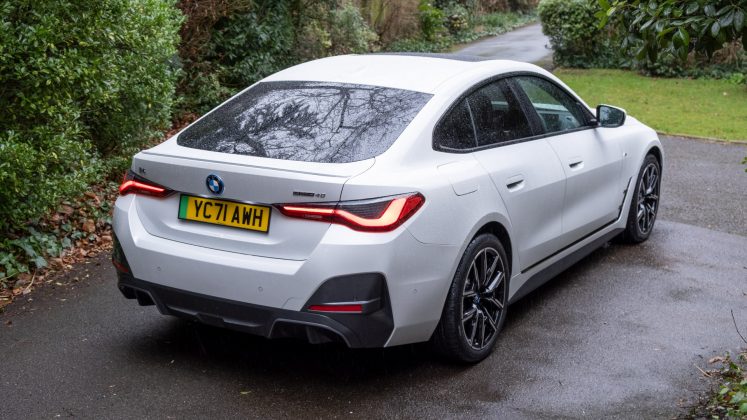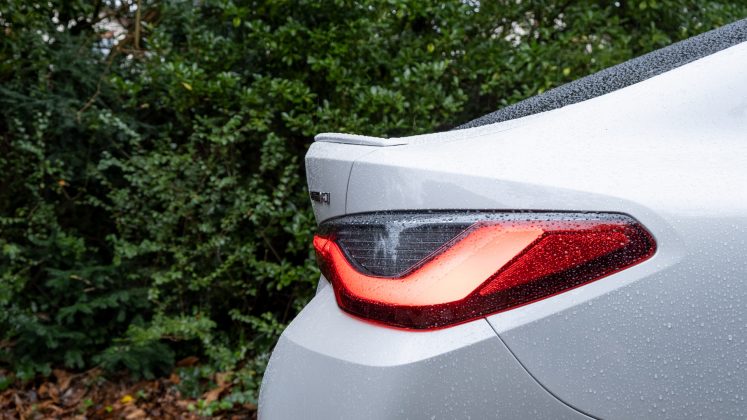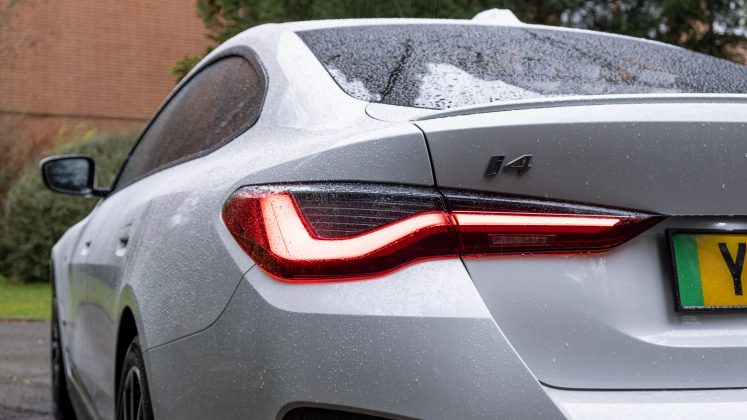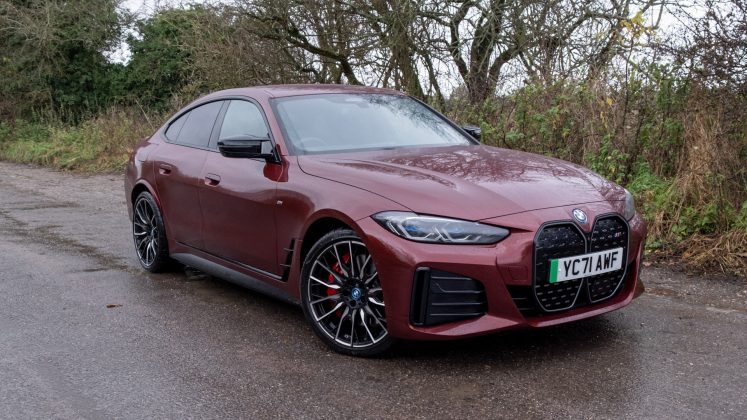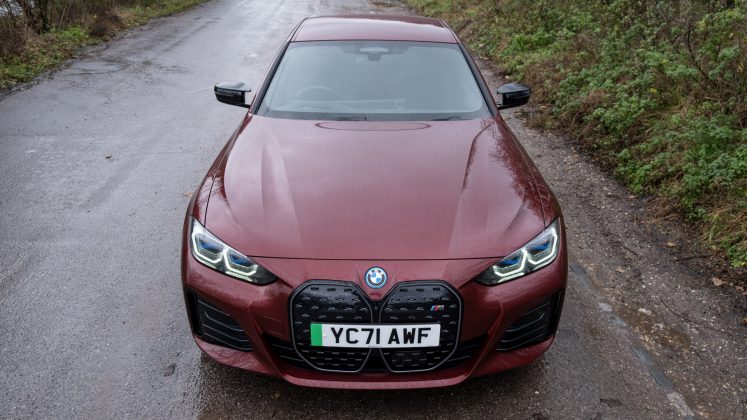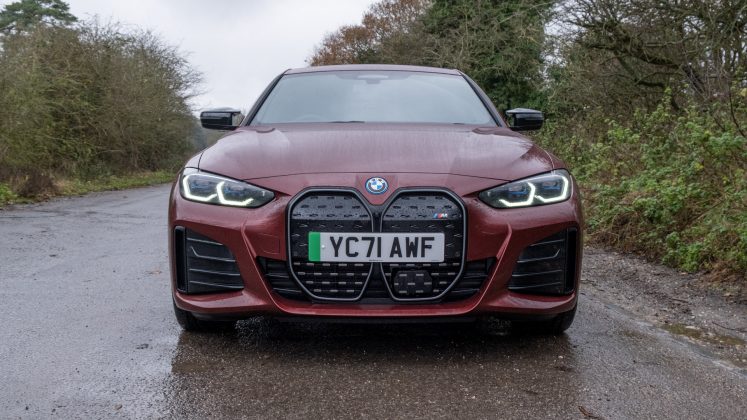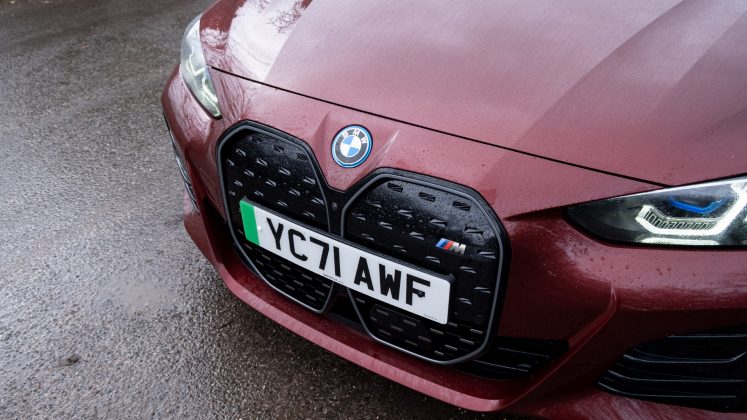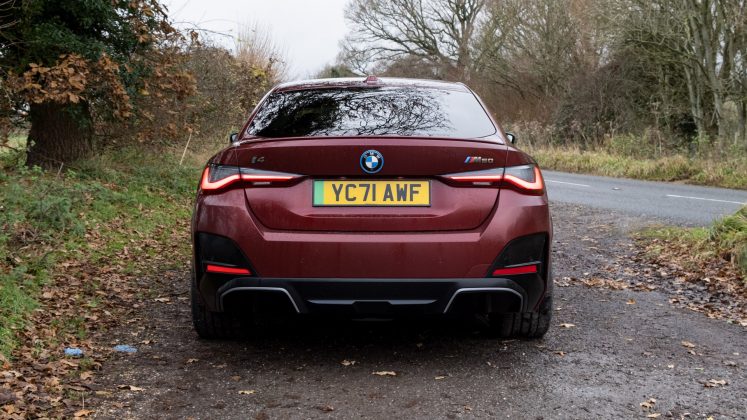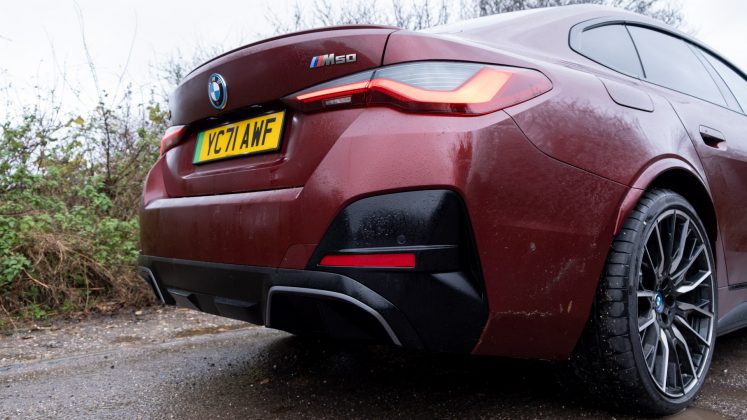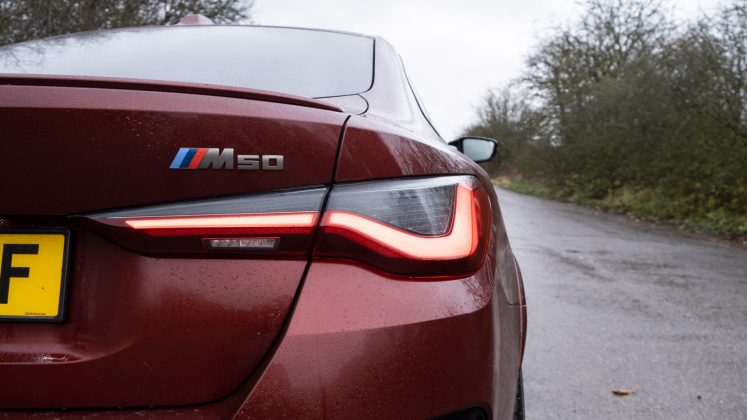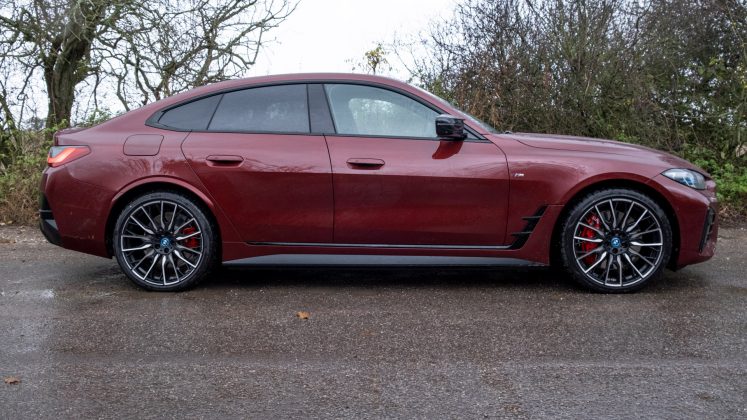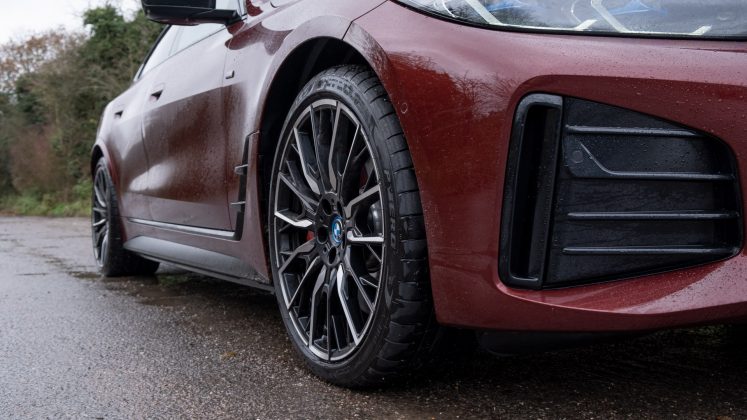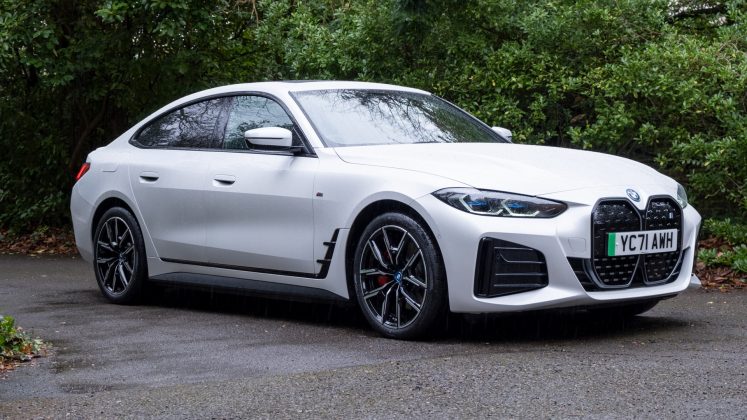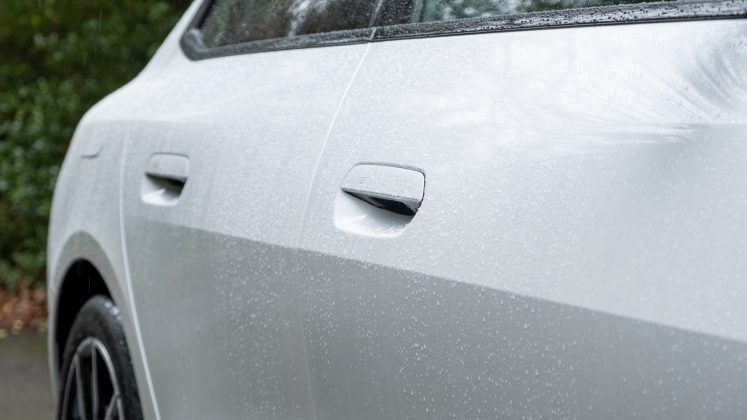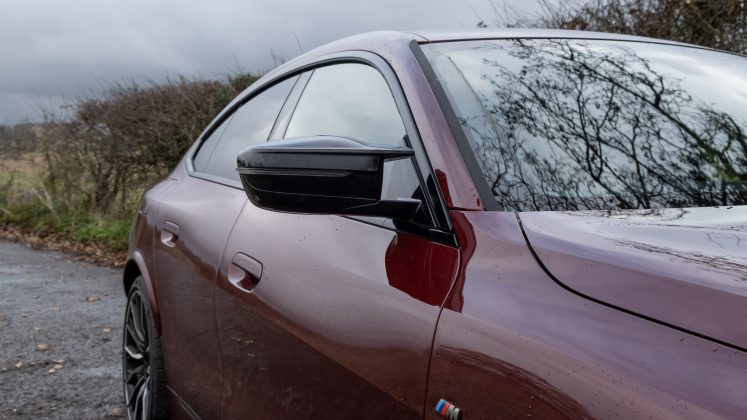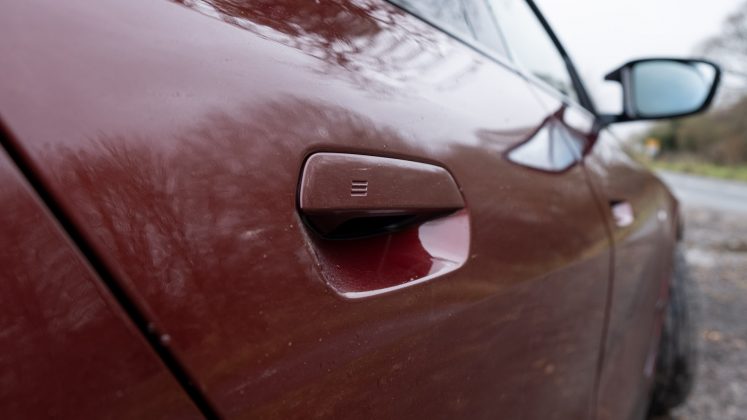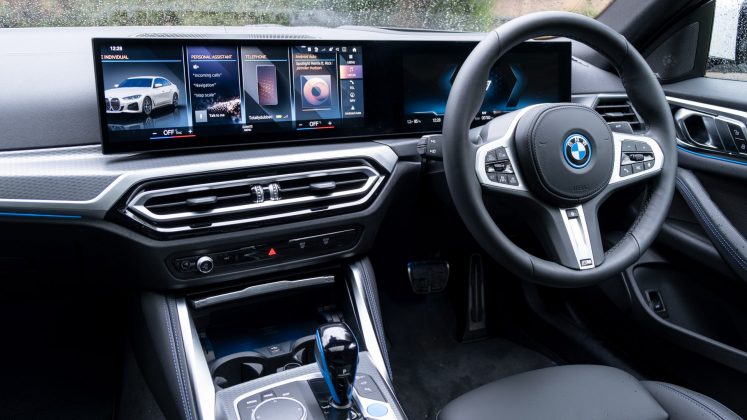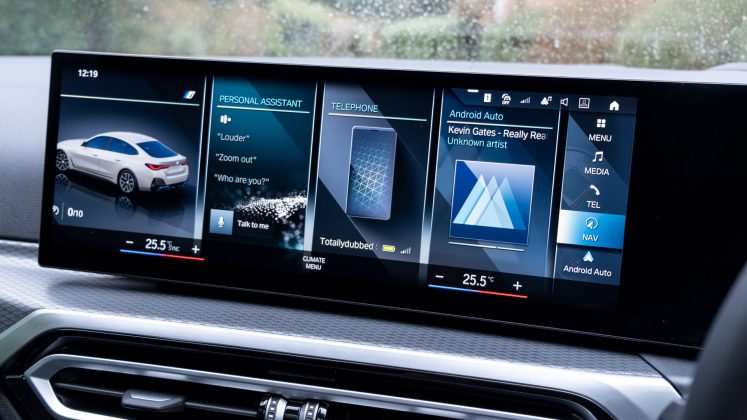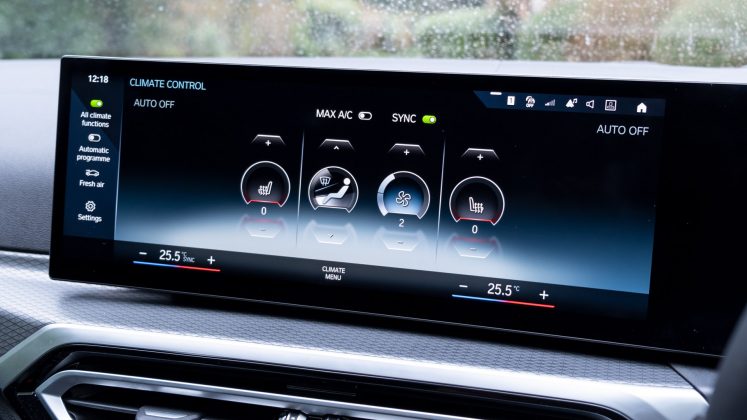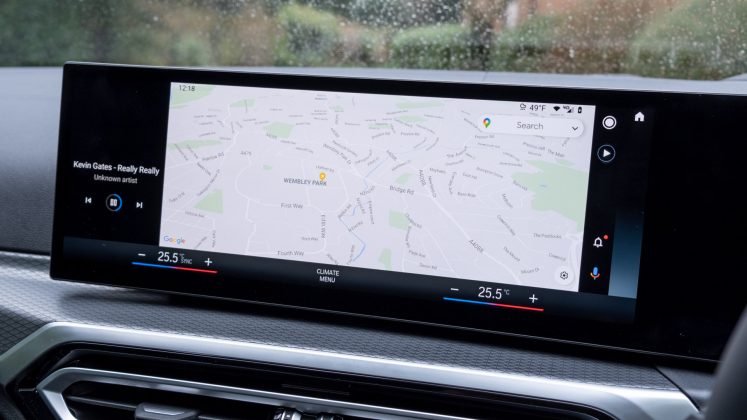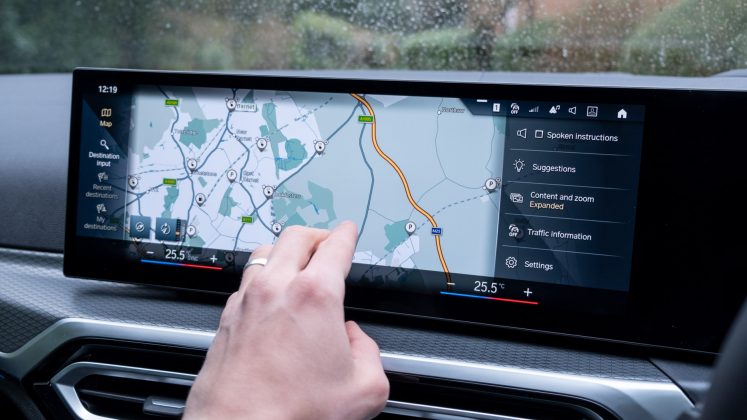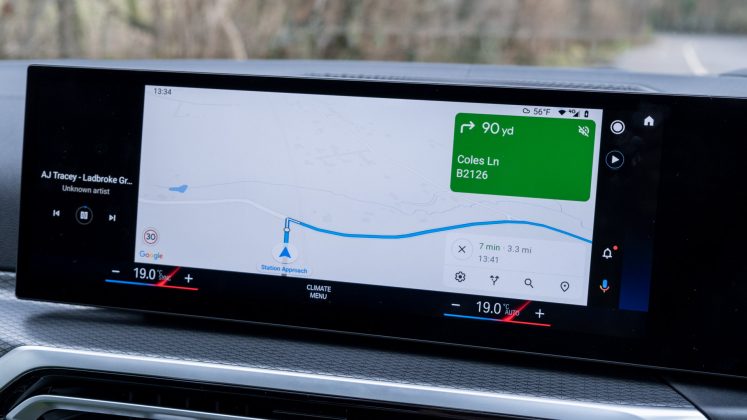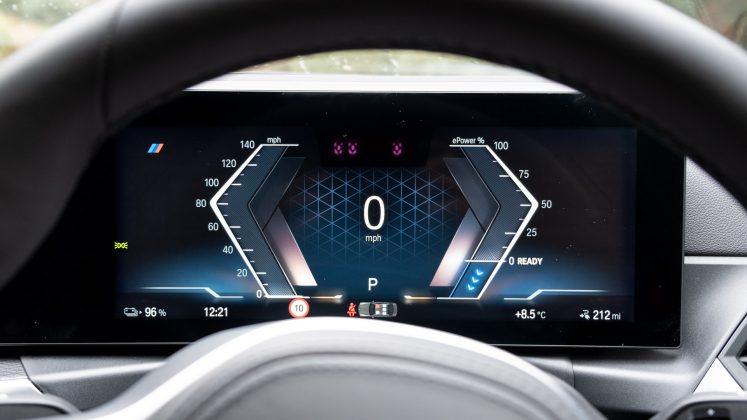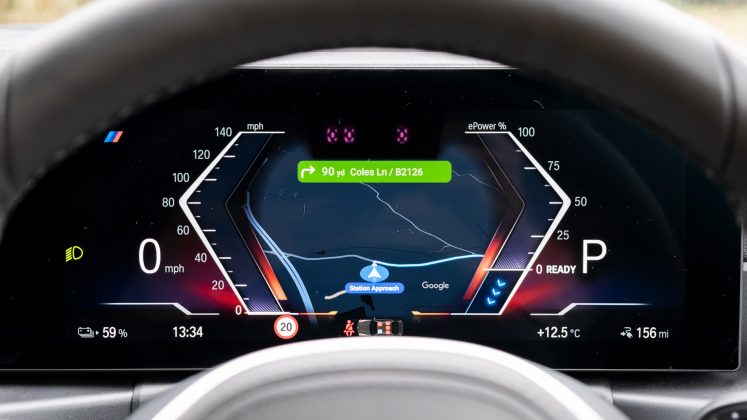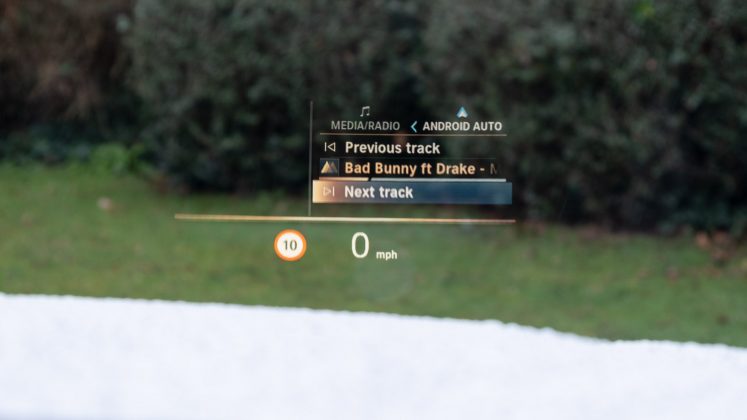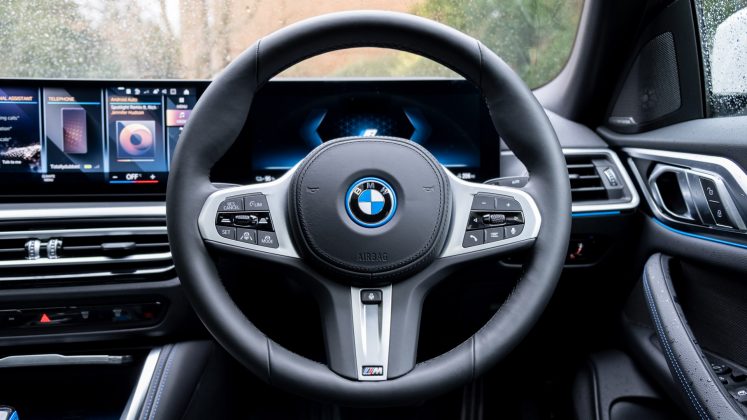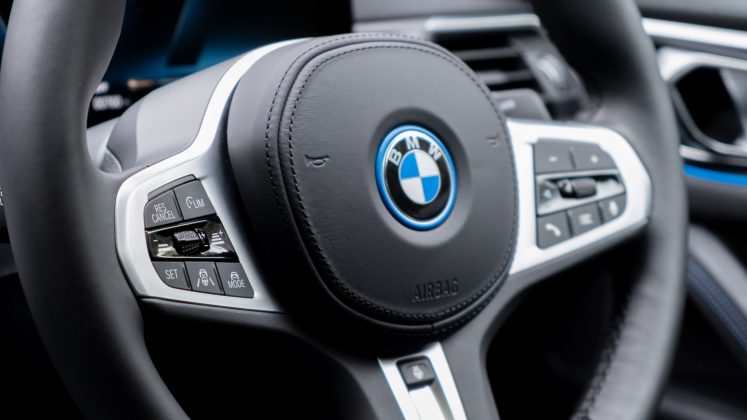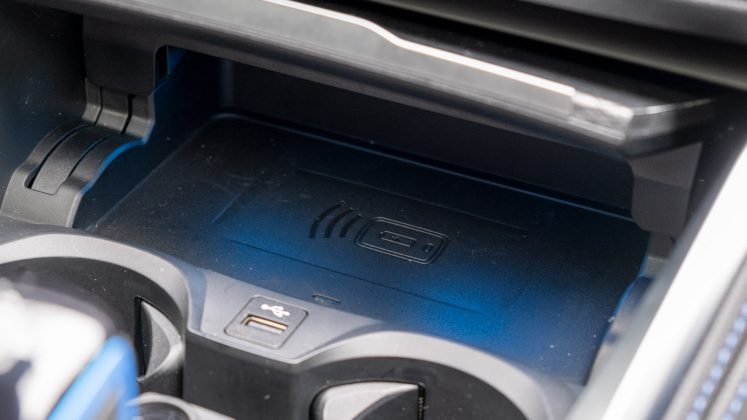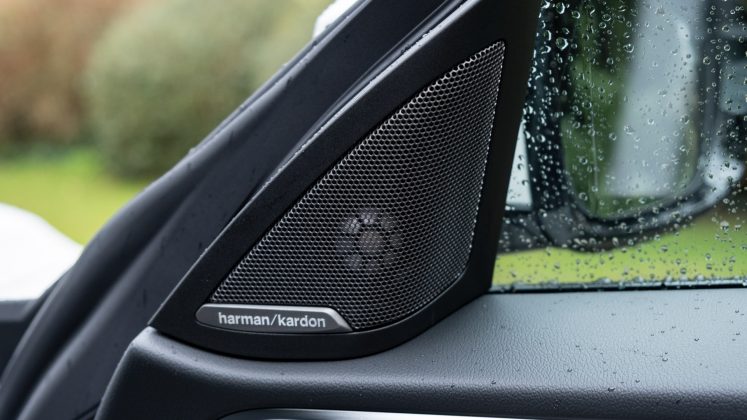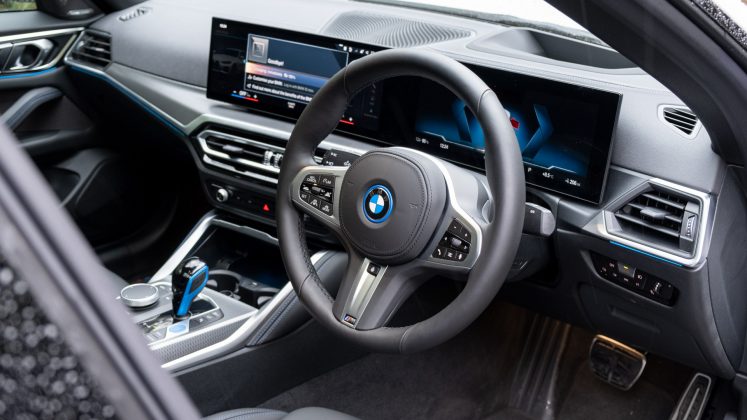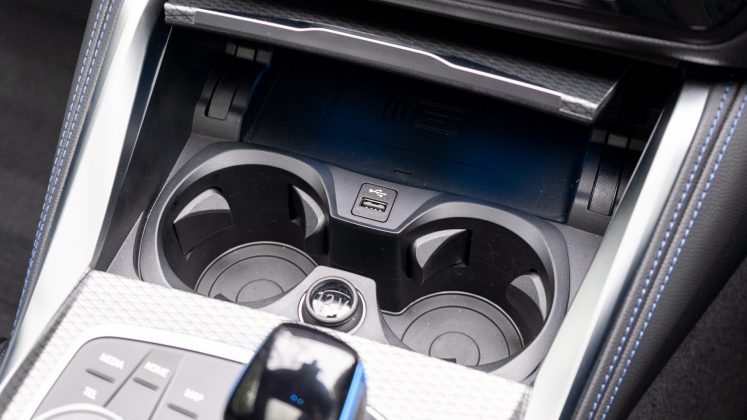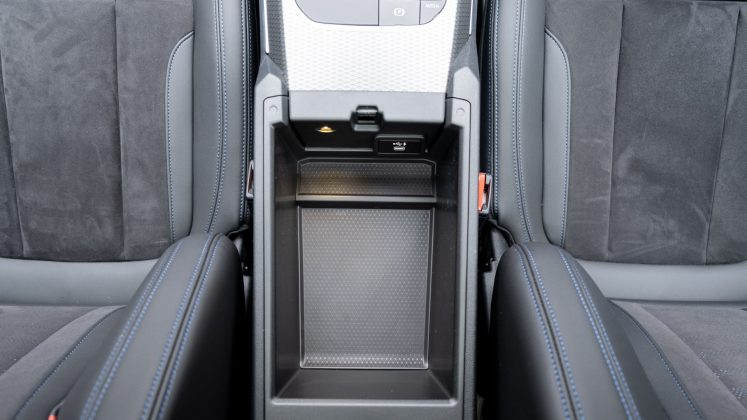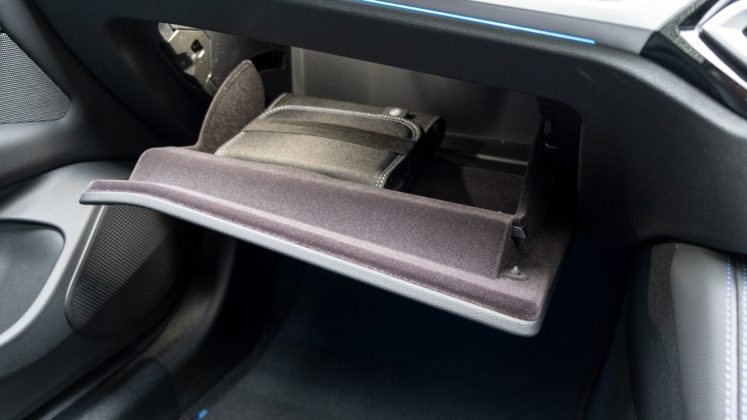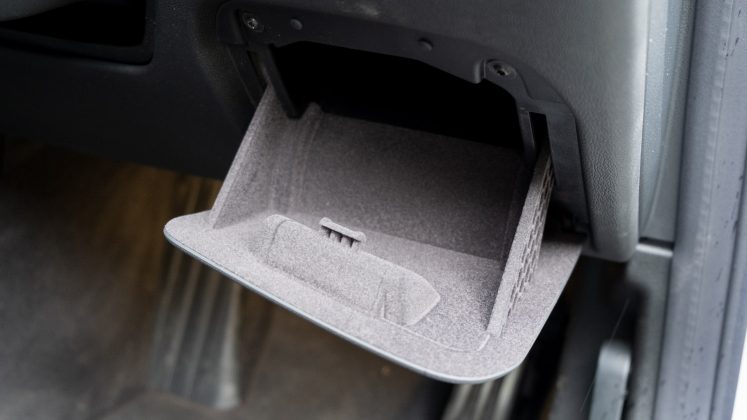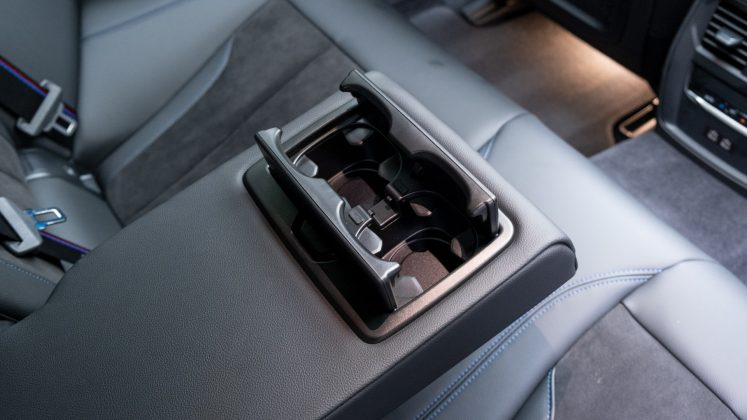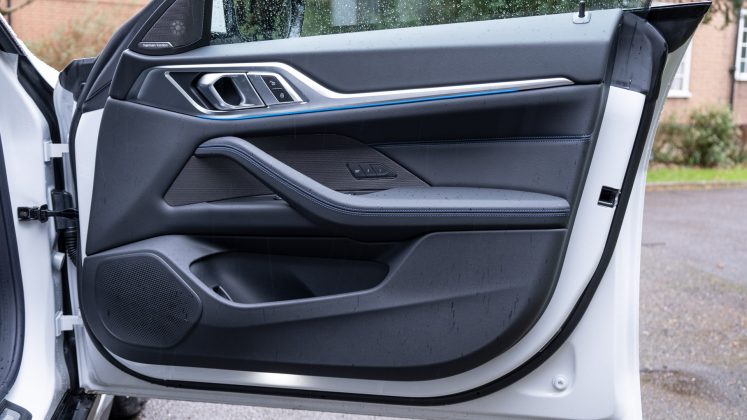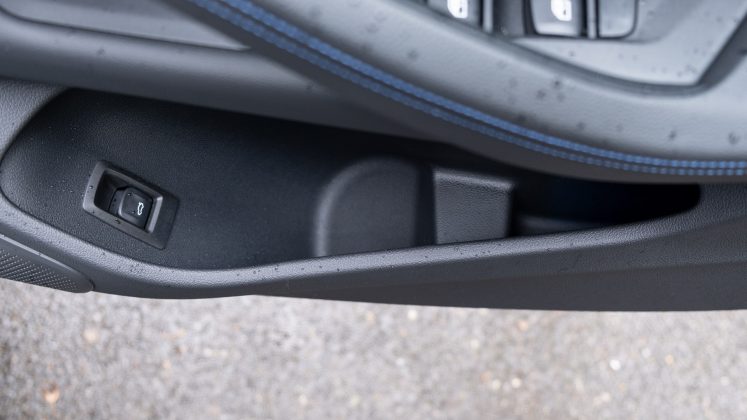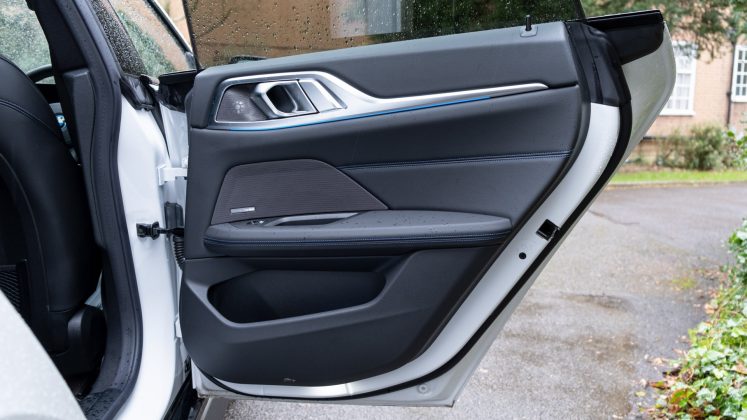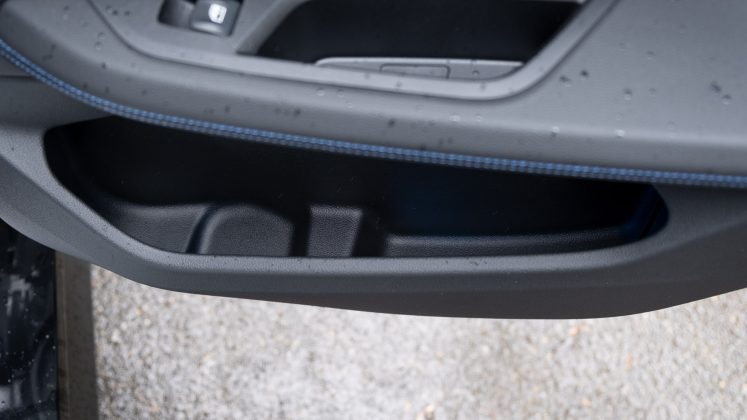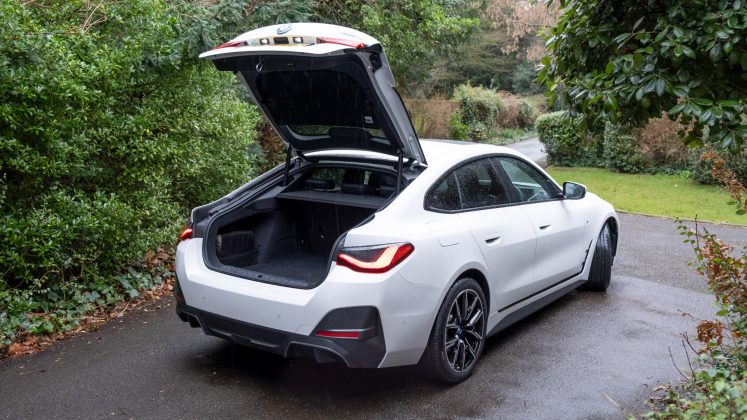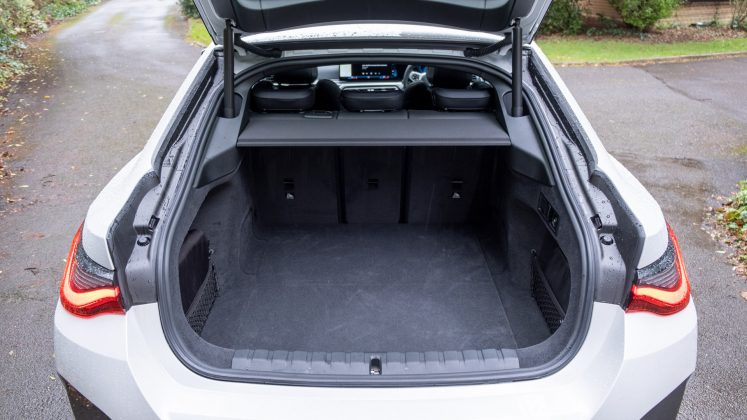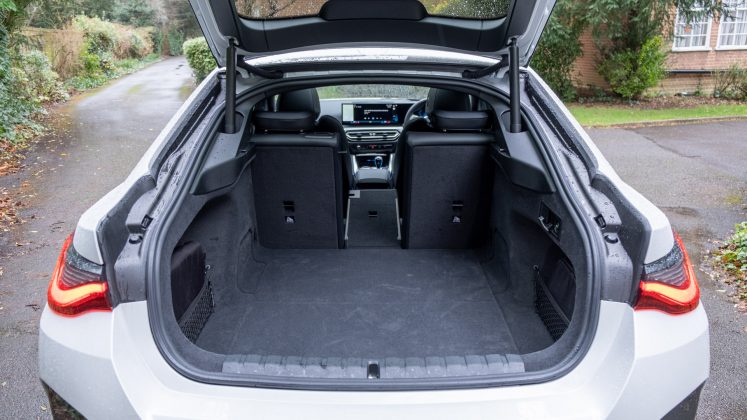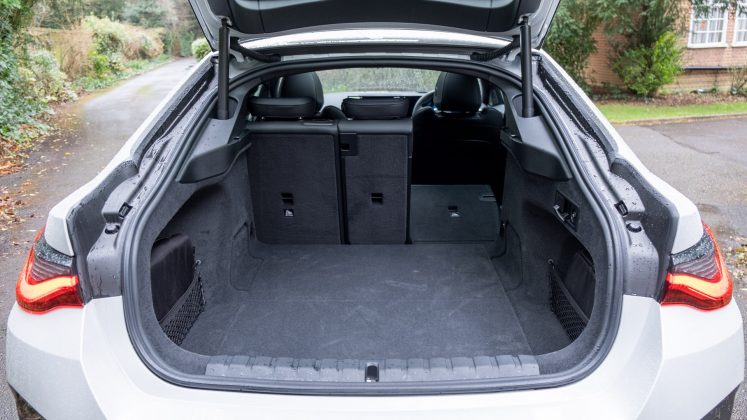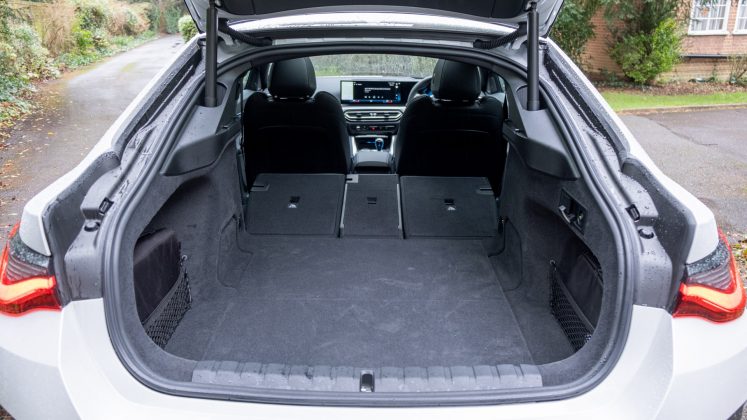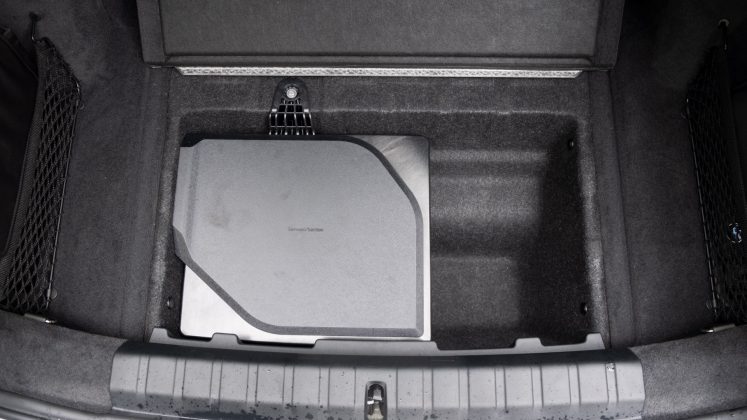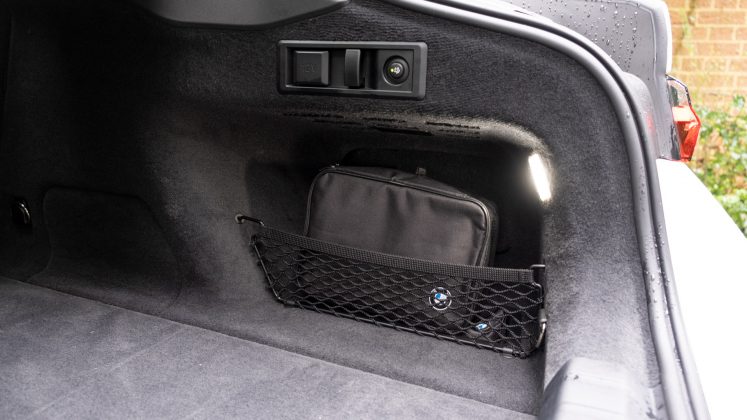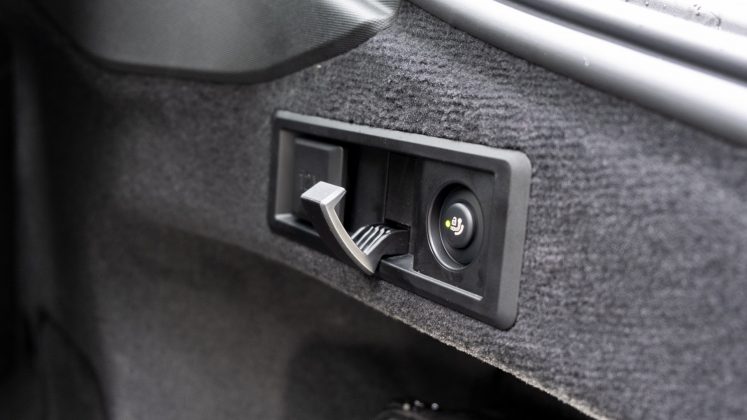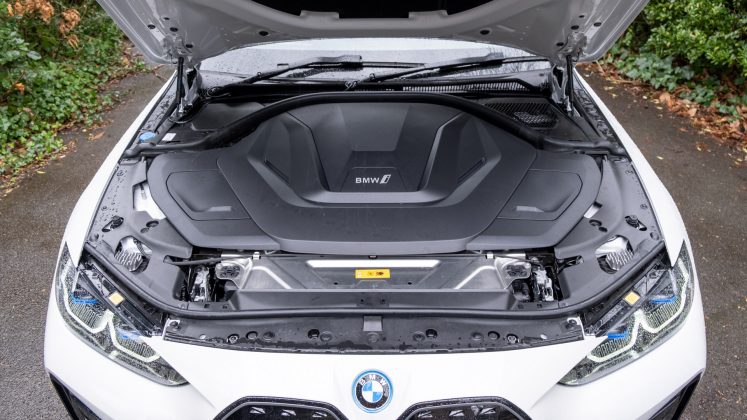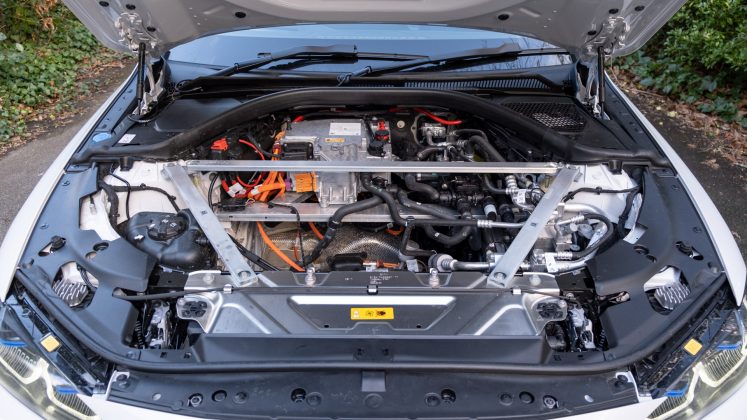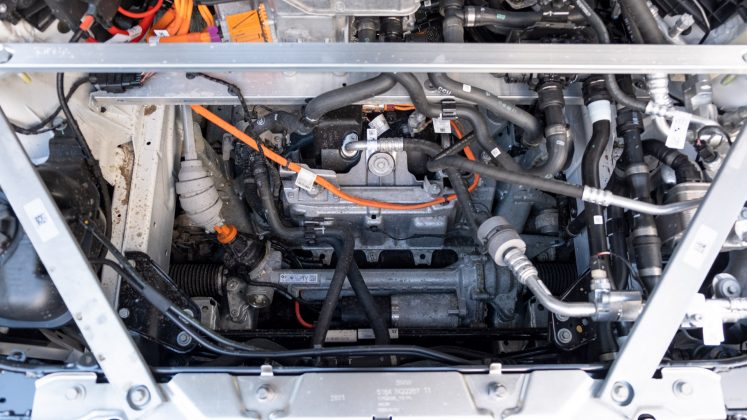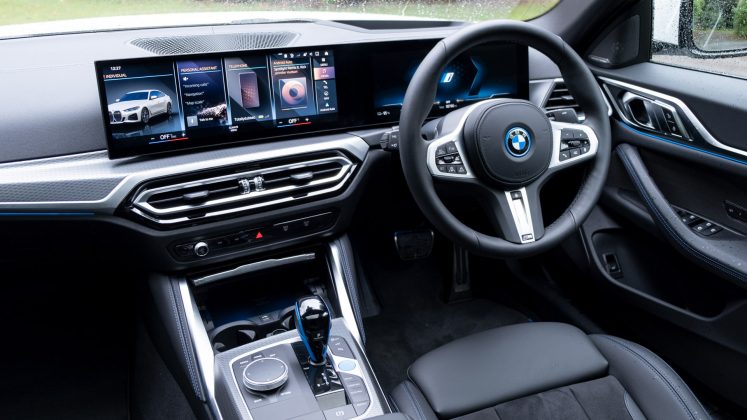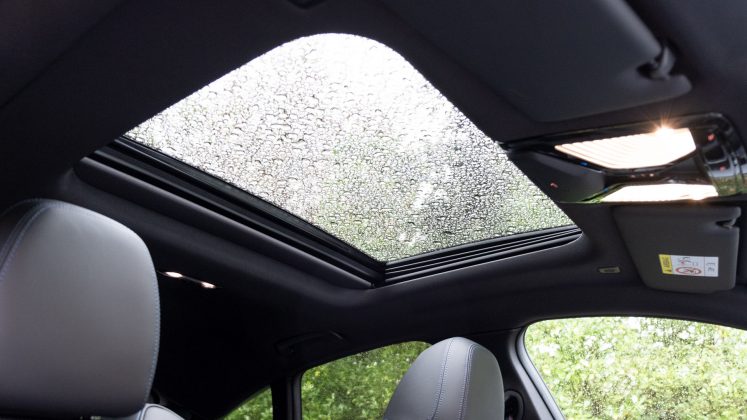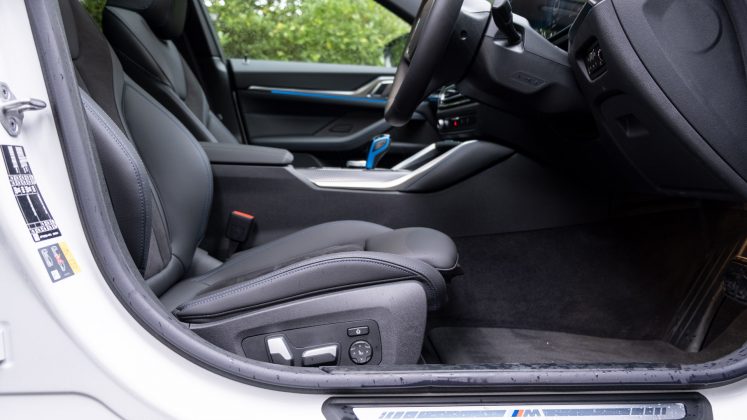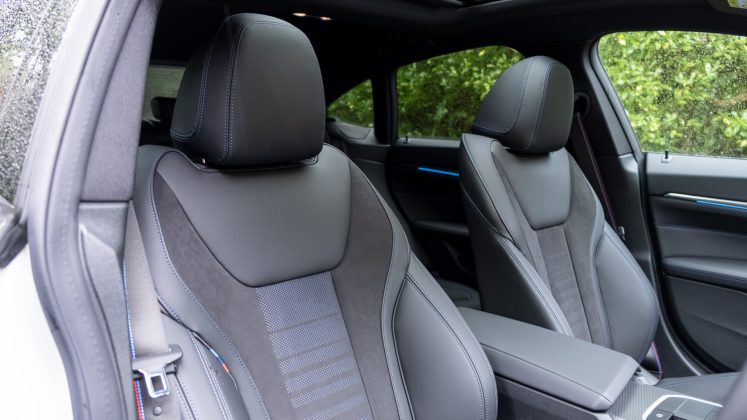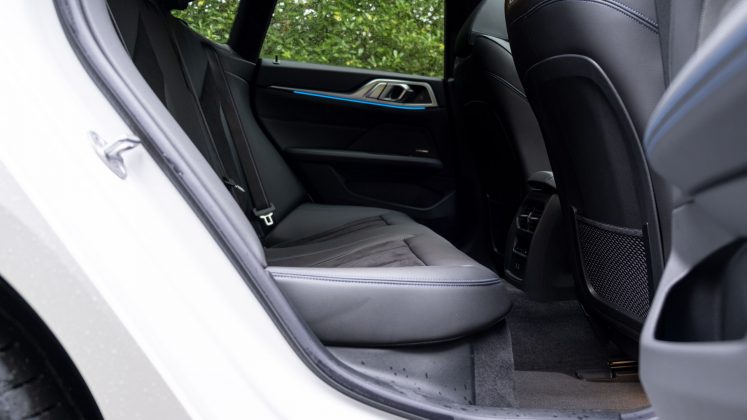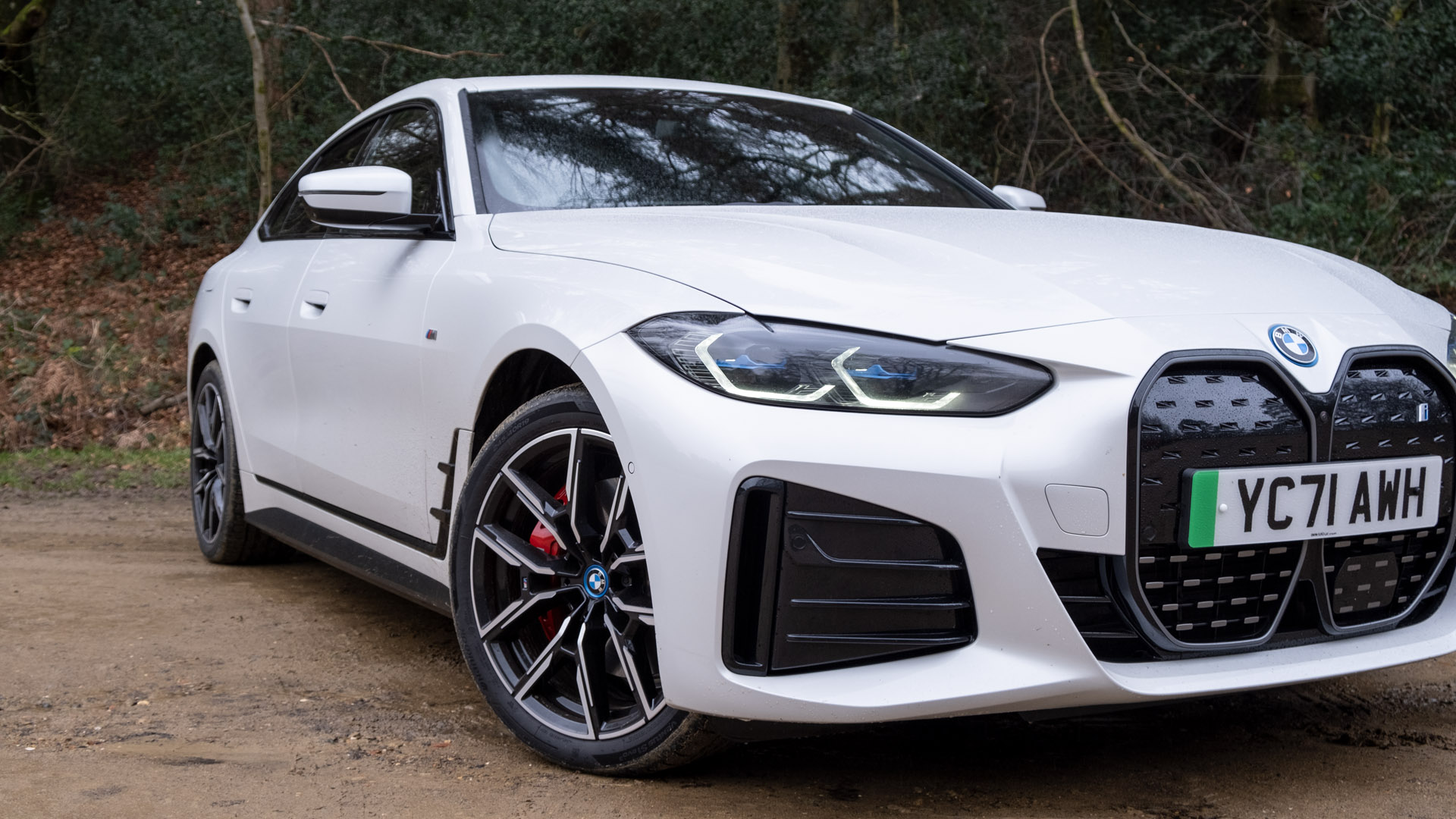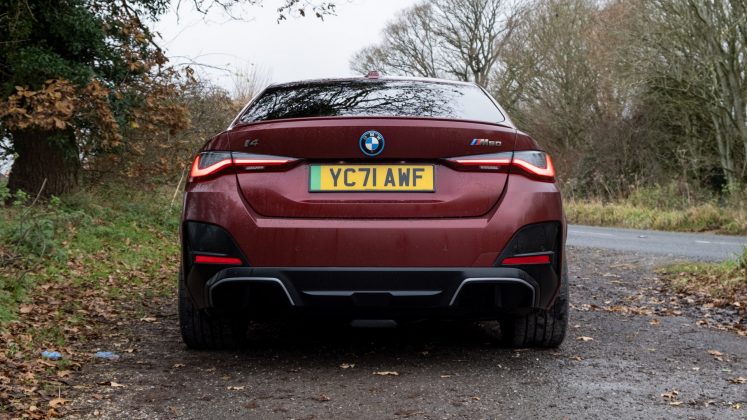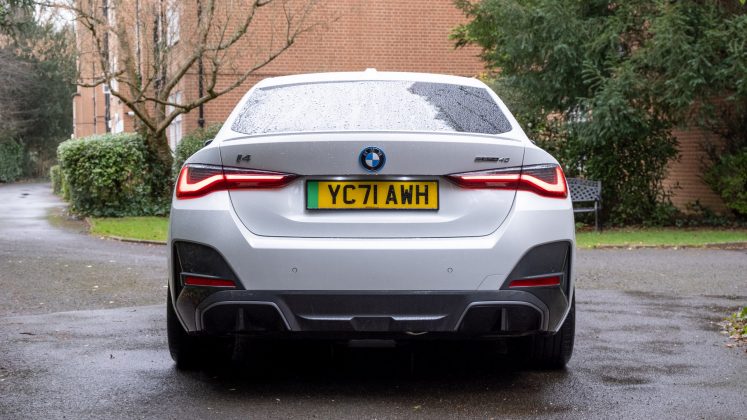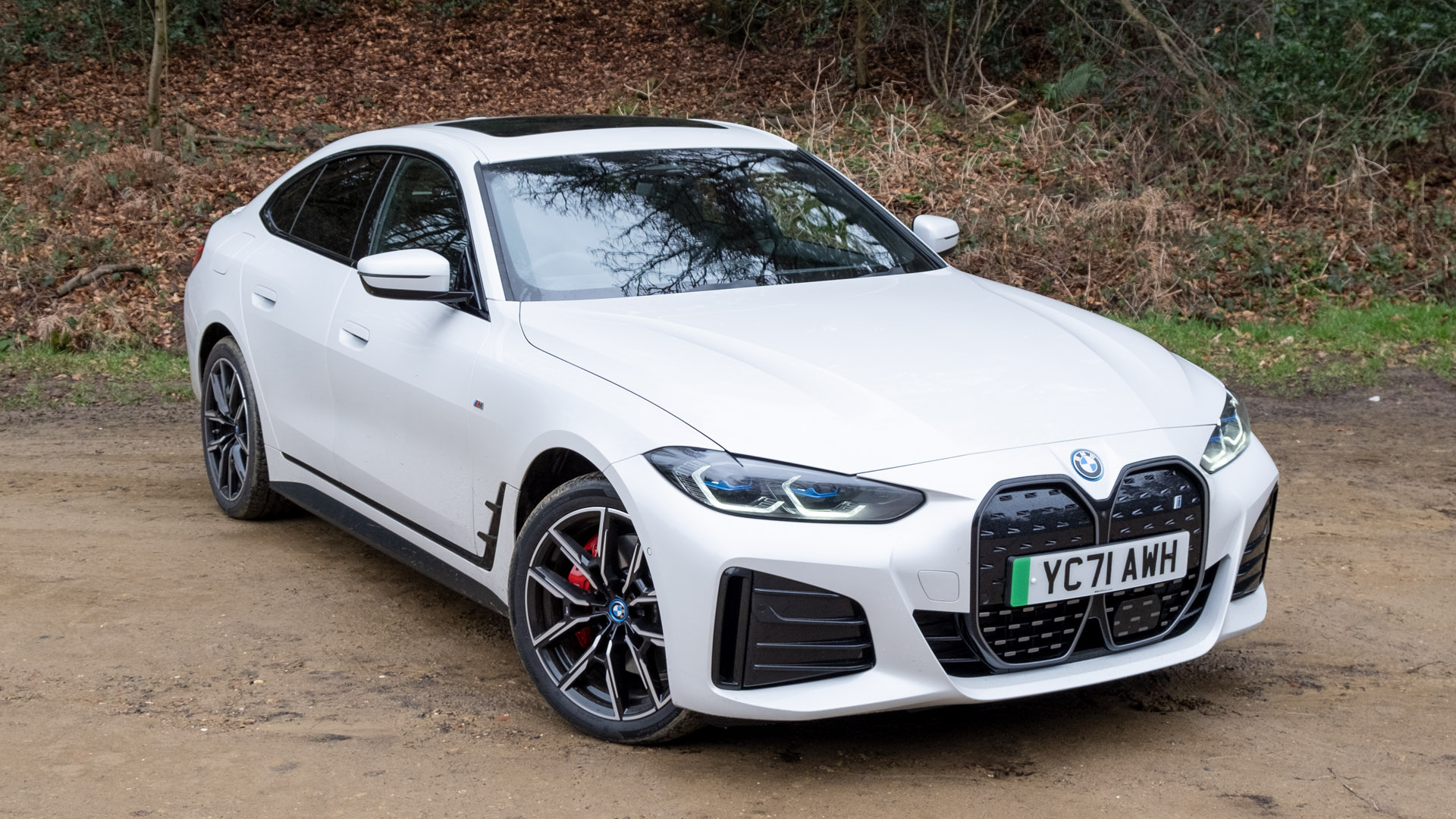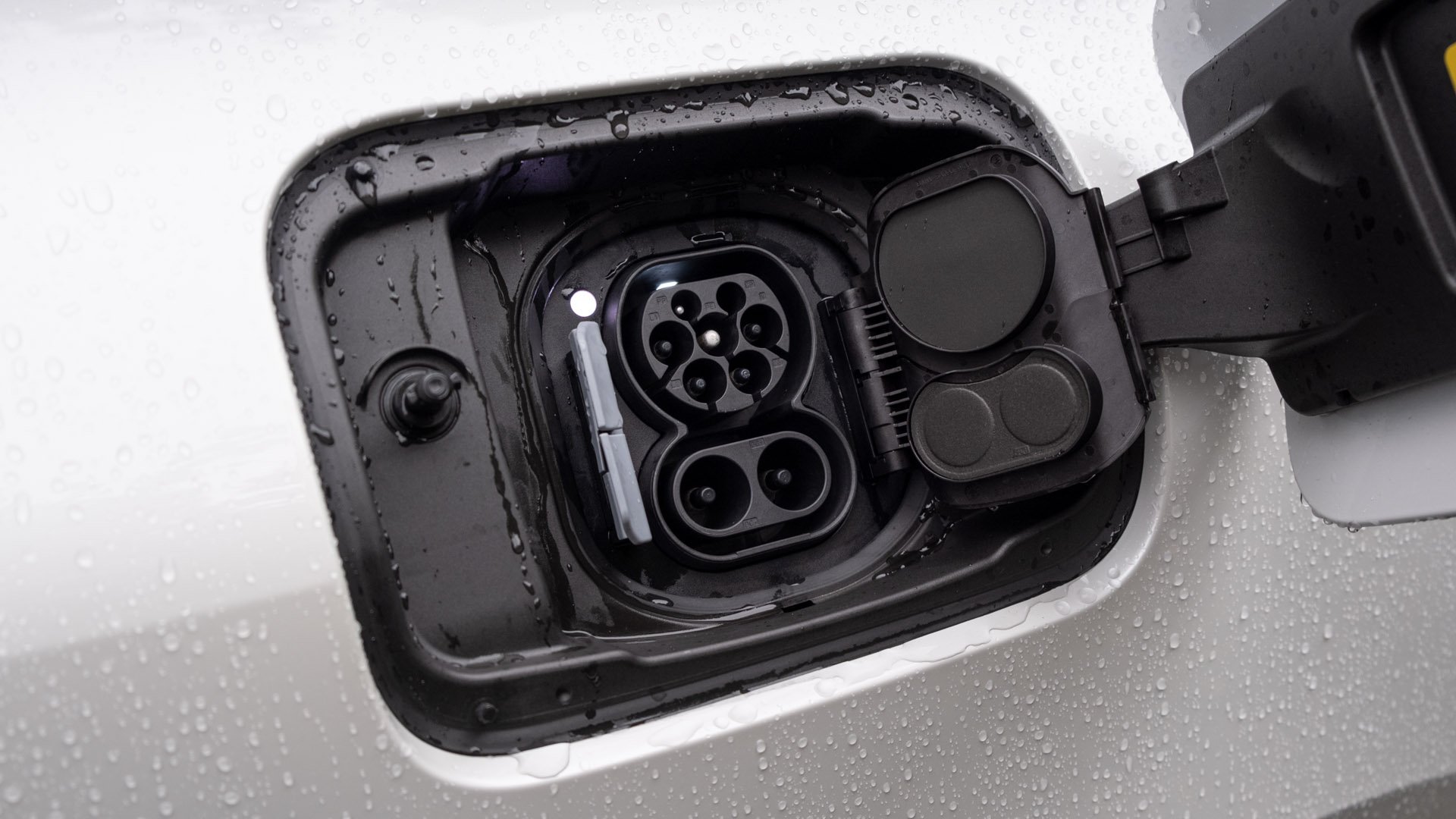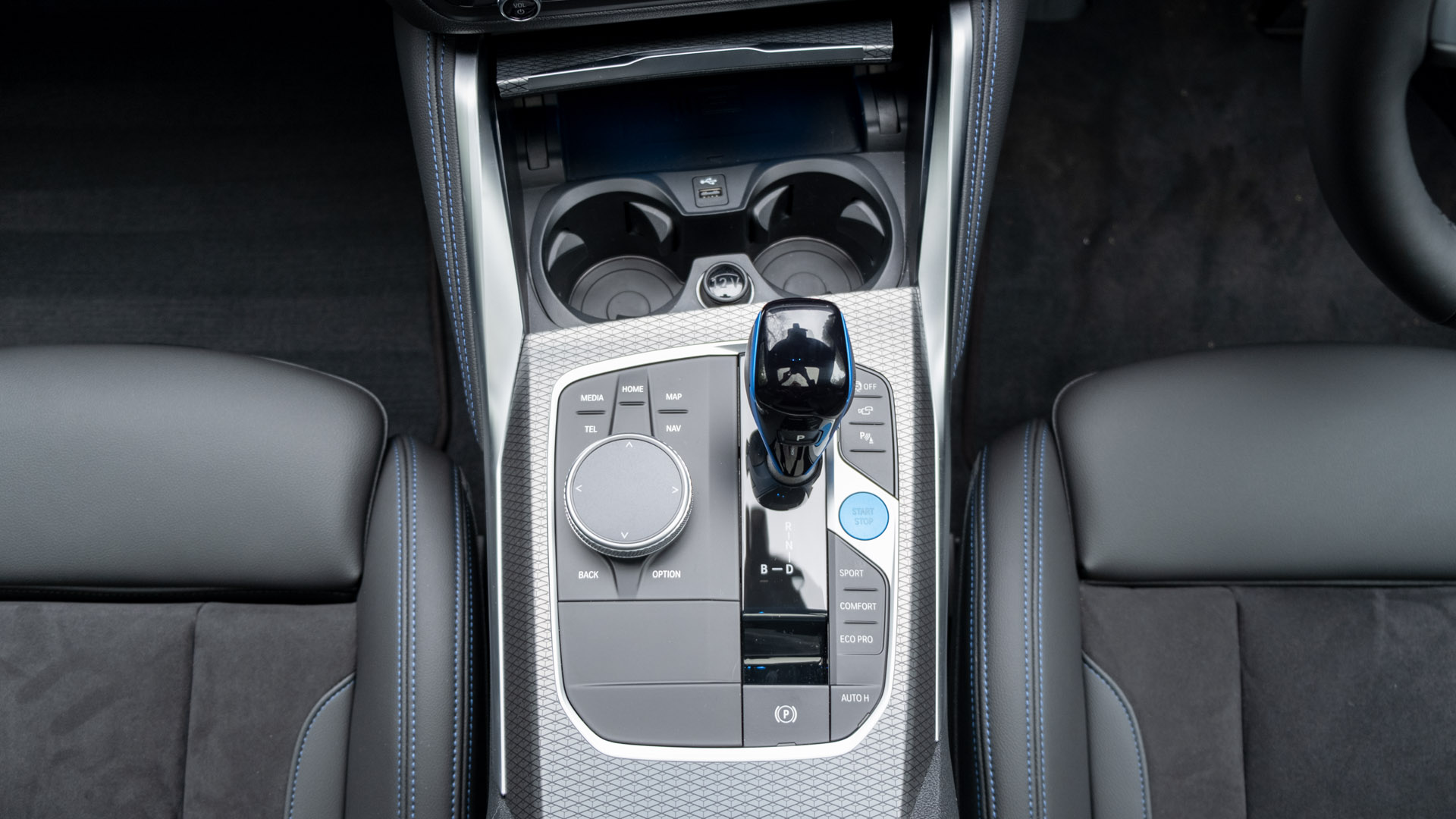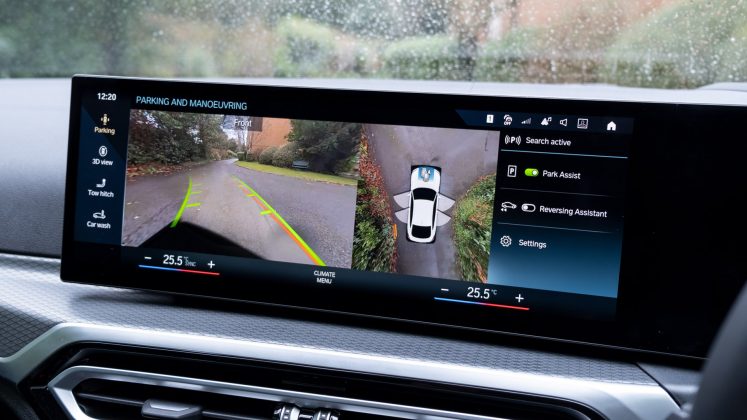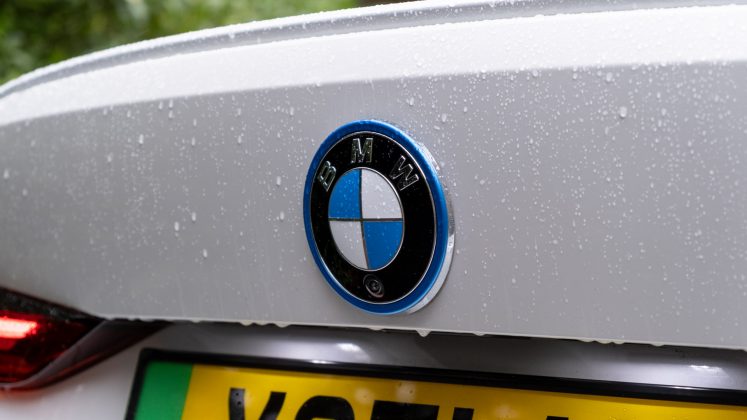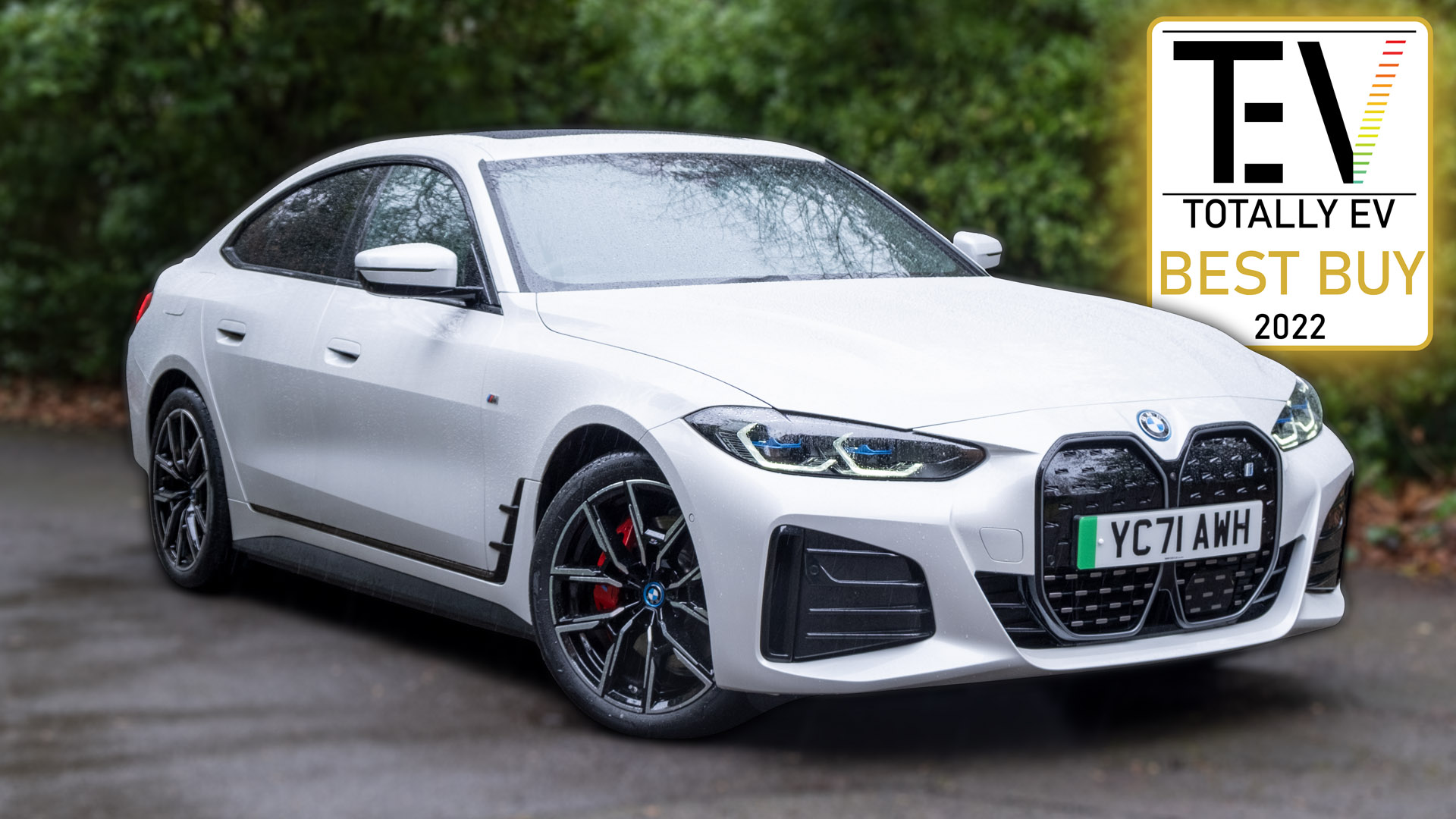The i4 is BMW’s first all-electric Gran Coupé, where it’s based on the same Cluster Architecture (CLAR) platform as other vehicles from the German automaker, such as the 4 Series.
At the time of writing, the BMW i4 is available with a rear-wheel drive (RWD) configuration, the eDrive40, and as an all-wheel drive (AWD) sports saloon, the M50. The latter model also marks the first-ever M-badged fully electric vehicle.
If you’d prefer to watch a review of the BMW i4, head on over to our YouTube channel.
BMW i4 price & competition
The i4 eDrive40 Sport starts from £51,905, with the M Sport variant coming in at £53,405, while the i4 M50 starts from £63,905. While there are a few cosmetic changes between the three models, the biggest difference comes in form of performance and range.
The M50 has two electric motors operating on an AWD system, which combined with its 83.9 kWh (80.7 kWh net) battery pack, outputs 405 kW (544 hp) of power and 795 Nm of torque. The sportier i4 has a claimed range of 258-323 miles.
By comparison, the RWD eDrive40 has 250 kW (340 hp) of power and 430 Nm of readily-available torque. Due to it housing the same number of battery cells as the M50, but instead housing only a rear-mounted motor, the least expensive i4 has a claimed range of 306-367 miles.
When it comes to competition, there are few all-electric vehicles to consider: the rapid Tesla Model S from £118,980; the responsive Porsche Taycan from £72,850; the supremely stylish Audi e-Tron GT from £80,850; the efficient Tesla Model 3 from £42,990; the sporty-looking Polestar 2 from £39,990; the futuristic Hyundai Ioniq 5 from £36,995; the hatchback VW ID.3 from £30,935; the practical Hyundai Ioniq Electric from £30,550; the compact Renault Zoe from £27,595; the fun-to-drive Mini Electric from £27,000; and the comfy Nissan Leaf from £25,995.
Read next: Audi e-tron GT review: Better than the Porsche Taycan?
BMW i4 exterior review
In comparison to some of its rivals, the BMW i4 certainly looks the part and is very similar to the 4 Series Gran Coupé and the new-generation M3 and M4. The front kidney grille dominates its frontal design but thanks to the numberplate breaking up its otherwise large-sized plastic insert, it blends seamlessly with the rest of the vehicle’s look.
The rear profile also keeps up with the manufacturer’s DNA, with the taillights giving the car an aggressive look. As for the rear bumper, it has plastic inserts that would have otherwise made way for outward-firing exhaust pipes in the ICE models.
Its side profile looks like any other modern BMW vehicle, where the pictured 19″ give the saloon an added sporty flair; 17-20″ sized rims are available as an option, whereby the smaller 17″ Bicolour Midnight Grey Aero-style 852 alloy wheels are reserved to the entry-level eDrive40, and the larger 20″ Bicolour Jet Black Double-spoke style 868 M alloy wheels to the i4 M50.
No matter which model you choose, you’ll notice BMW has concealed the door handles within the car’s frame, where we find these easy to operate and far more intuitive than those of the Tesla Model 3.
As for your colour options, it depends on which i4 you pick: the i4 eDrive40 Sport comes in the non-metallic Alpine White, and for £695 one can opt for metallic Black Sapphire, Mineral White, Sunset Orange, Sanremo Green or Skyscraper Grey.
The M Sport variant is also available in the metallic Portimao Blue and swaps the aforementioned grey finish for Brooklyn Grey. For £1,750 there’s also the Dravit Grey, Tanzanite Blue II and Aventurine Red III finishes.
The i4 M50 comes in the metallic Black Sapphire, Mineral White, Sunset Orange, Portimao Blue, Sanremo Green and Brooklyn Grey at no additional cost, while the Dravit Grey, Tanzanite Blue II and Aventurine Red III finishes cost £1,100, while the matte Frozen Portimao Blue costs a whopping £2,985.
Read next: Polestar 2 review: The all-electric muscle car
BMW i4 interior review
Aside from its stylish exterior design, the i4’s interior is similarly excellent; from the seat upholstery to the choice of materials used throughout the cabin. Our only complaint is that the German automaker has omitted physical climate controls on the dashboard, and instead opted to place them on the centre-weighted 14.9″ display – it’s less intuitive to adjust the temperature, fan speed and seat heaters while on the move.
Nevertheless, the vehicle’s infotainment system is extremely responsive, vivid and provides a logical menu system that’s easy to navigate. Better still, it supports Android Auto and Apple CarPlay in both a wired and wireless format.
BMW’s integration of technology doesn’t stop there, as the 12.3″ instrument cluster and Head-Up Display (HUD), perfectly integrate navigation data from these third-party operating systems. The HUD comes as standard within the M50 but will require you to opt for the £1,900 ‘Technology Pack’ in the eDrive40 variant.
The said pack also adds a 16-speaker 464-Watt Harman Kardon audio system into the mix; should you not want the HUD, this can be added separately for £820 on the eDrive40, but again, comes as standard within the M50. The upgraded audio configuration seriously bolsters the listening experience within the cabin and will be a delight to those who appreciate music. If you’d like to hear how the Harman Kardon system sounds, watch our detailed review on YouTube.
To interact with the instrument cluster or HUD, physical buttons that reside on the steering wheel allow you to easily tinker with your settings or adjust the view. As for the centre-weighted display, it can be also navigated using the iDrive rotary wheel, which resides by the centre console alongside a flurry of physical buttons and the gear selector.
In this area, you’ll also find two cupholders, a USB Type-A port and a wireless charging pad for your smartphone. The latter costs an additional £180 in the eDrive40 and is included as standard within the M50.
Read next: BMW iX3 review: The best driver’s feel?
BMW i4 storage review
On the subject of storage, the i4 offers a limited amount of space within the cabin. Here, it’s got a far smaller centre console compartment than the Tesla Model 3, whereby one can only fit a small-to-medium-sized purse or wallet and a few smaller valuables. Should you want to take anything larger, you’ll have to rely on the compact glove compartment or the front door bins, which are large enough to fit a 500ml bottle. The rear door bins are unsurprisingly limited.
Another area of disappointment is the lack of frunk storage; with the i4 sharing the same platform as its ICE-based siblings, the area under the bonnet is completely wasted. Here, you’ll find a void of empty space with a myriad of electronics.
Thankfully, however, the i4’s boot capacity is excellent. There’s 470 litres with the seats in place and with them folded flat, extends to 1,290 litres. Here’s how it compares to its rivals: Hyundai Ioniq 5 (520/1,587 litres); Nissan Leaf (435/1,161 litres); Hyundai Ioniq Electric (357/1,417 litres); Tesla Model 3 (425/1,235 litres); Audi e-tron GT (405/1,150 litres); VW ID.3 (385/1,267 litres); Polestar 2 (405/1,095 litres); Porsche Taycan (366/1,100 litres); Renault Zoe (338/1,225 litres); Mini Electric (211/731 litres).
To bolster practicality, BMW incorporates an electronically-operated tailgate with a hatchback design, a flat loading bay, 40:20:20 split-folding rear seats and an underfloor boot compartment, which is ideal for storing charging cables. Note, if you opt for the Harman Kardon audio system, you’ll find the latter area taken up by a sizable HK-branded box.
To heighten the experience, you might want to opt for the £990 ‘Comfort Pack’, which includes rear nets, hooks and a 12V socket in the boot, alongside USB-C ports at the rear of the centre console, a heated steering wheel and keyless entry.
Read next: Hyundai Ioniq 5 review: Better than Tesla Model 3?
BMW i4 comfort review
This leads us onto comfort, which is arguably the vehicle’s biggest flaw and equally best trait. Starting on the negative side, the i4 doesn’t include the aforementioned features as standard, something that one might expect in a premium vehicle. Similarly, should you want electric front seats with driver memory and front lumbar support you’ll need to splash out £1,950 on the ‘Comfort Plus Pack’ or an additional £960 on top of the regular ‘Comfort Pack’ – the M50’s ‘Comfort Pack’ costs £1,200 as the vehicle has electric front seats fitted as standard.
Elsewhere, the ‘Electric Glass Sunroof’ costs an additional £1,050. While this brings in much-needed extra light to the front of the cabin, it doesn’t help rear occupants. Indeed, unlike the Polestar 2 or Tesla Model 3, which both incorporate panoramic glass roofs, the i4 opts for a small sunroof only; on the other hand, this can be opened to bring in fresh air, whilst its competitors have a fixed glass roof instead.
The biggest complaint, however, doesn’t allude to options but rather, the inconvenient access of the rear of the cabin. Here, the design of the C-pillars makes it hard for adult individuals to easily get in and out of the back seats. While this is a non-issue for kids or teenagers, it’s worth noting that most of its competitors don’t suffer from such a problem.
Similarly, headroom and legroom are both limited at the rear of the cabin whereby 6-foot 4-inches (193cm) individuals might feel a little henned in; the positioning of the seats also means that rear occupants might have tired quad muscles on longer trips. It’s also a shame that BMW has preserved the transmission tunnel rather than incorporating a flat floor design for the rear middle occupant – similar to what Tesla achieved with the Model 3.
On the plus side, accessing the front of the cabin isn’t anywhere near as tricky and the seats are both heated and accommodating for all body types – headroom and legroom are both plentiful, too.
No matter where you’re sitting, cabin noise is kept down to a minimum. While the i4’s interior isn’t as serene when compared to the Tesla Model 3 or Porsche Taycan, it’s still among the best in the market.
Read next: Tesla Model 3 review (2021 facelift): Should you buy into the hype?
BMW i4 performance review
What really sets itself apart from its competitors, however, is the i4’s suspension setup. The tested model with its adaptive suspension system is a true marvel, whereby it soaks up anomalies of the road, speed bumps and potholes with ease, while still providing excellent driving dynamics around windy country roads.
Our only complaint, however, is that it doesn’t come fitted as standard in the eDrive40, rather comes in at a £4,000 premium over the entry-level model £51,905 i4 Sport; indeed, you’ll need to opt for the £53,405 ‘M Sport’ model and add the £2,500 ‘M Sport Pro Pack’ on top to attain a buttery smooth experience. Should you not see the benefit nor have the budget, the stock eDrive40 operates on rear air suspension only, thus still providing bettered driving comfort over the Tesla Model 3 or Polestar 2. Thankfully, the adaptive suspension system comes fitted as standard in the £63,905 i4 M50.
Nevertheless, no matter which model you choose the i4 also has one of the best driver’s feel one can attain in an EV, where it’s only beaten by the likes of the Porsche Taycan. Here, the i4, easily surpasses the Tesla Model 3, Polestar 2 and to a degree the Audi e-tron GT, too; you’ll feel connected to the front axle, and thanks to the excellent driving position, one has a sense of control and awareness when cornering. The i4 bring a real sense of enjoyment, be it on track or around challenging country roads.
When it comes to traction, the eDrive40 operates on rear-wheel drive (RWD) configuration, while the sportier M50 on an all-wheel drive (AWD) system instead. The former feels a little uncontrolled when putting your foot down to the metal on wet tarmac, while the latter model feels glued to the ground and provides bettered grip around corners.
Similarly, when it comes to power output, the M50 is superior to its cheaper sibling, whereby it outputs 405 kW (544 hp) of power and 795 Nm of torque from its twin-motor configuration. This launches it to 60mph from a standstill in a tested 4.04 seconds, although, we suspect one can attain sub-four seconds in drier conditions. By comparison, the eDrive40 was tested at 5.32 seconds; this is due to the entry-level model offering a single rear-mounted motor, which outputs 250 kW (340 hp) of power and 430 Nm of readily-available torque. As for top speed, the M50 can attain 138.8mph, while the eDrive40 sits a little lower at 118mph.
Buy a car phone mount on Amazon (Affiliate)
Undoubtedly, the i4 M50 has better performance and comfort over its cheaper sibling and competitors, however, it can’t quite boast the same electric range as its sibling. See, both of BMW’s models house the same 83.9 kWh (80.7 kWh net) battery pack, which means the slightly lighter (2,125kg vs 2,290kg) and more efficient eDrive40 achieves a longer range. We had it tested at 240-260 miles in our mixed driving tests. While we couldn’t put the M50 through the same tests, we achieved 200-210 miles in our first drive.
Compared to its competitors, the i4 eDrive40 achieves a similar range to the Polestar 2 (with heat pump at 240-250 miles), the entry-level Tesla Model 3 (230-250 miles), the Audi e-tron GT (230-250 miles) and trumps the Porsche Taycan (190 miles). While the eDrive40 is better or equivalent to most of its rivals, Tesla’s Long Range AWD, which achieved around 310 miles in our mixed driving tests, still reigns supreme when it comes to range and efficiency.
Another area where the i4 falls short of its Tesla counterpart is when it comes to the charging infrastructure. Unlike the American automaker, who provides a reliable Supercharger network, BMW’s consortium – Ionity – has a limited number of rapid chargers throughout the country and will therefore mean you’ll have to rely on EV charge points that are operated by third-party suppliers; they’re not as hassle-free as what Tesla offers.
Nonetheless, if you are to find an Ionity (or other-branded) rapid charger, the i4 supports a gigantic 200 kW input allowing you to go from 10-80% charge in just 31 minutes via its CCS port. Opt for a more commonly found 50 kW charge point and it’ll take one hour instead. On an 11 kW three-phase home or workplace charger, it’ll take 8hrs 25mins to go from empty to full using the i4’s Type 2 port, while it’ll take 13 hours on a 7 kW input and a whopping 35 hours when connected to a 3-pin wall plug.
Should you wish to recoup energy while on the move, BMW offers numerous regenerative braking modes. Through the infotainment system, you can customise how the vehicle behaves when lifting off the accelerator pedal while in ‘D’, with ‘Adaptive’ mode providing an intelligent system that recognises when to bring the vehicle to a complete standstill. The other modes, such as ‘High’ won’t completely slow down the car.
The issue with ‘Adaptive’ mode, however, is that you have to rely on the car to correctly identify a junction or object, which means that if you want to decelerate while on country roads you’ll need to apply pressure on the brake pedal. Thankfully, ‘B-mode’, which can be enabled by shifting left on the gear selector, allows you to do just that; the level of deceleration is similar to that of the BMW i3, Tesla Model 3 and Polestar 2 – all of which provide a means of one-pedal driving.
It should be noted, however, that the BMW i4 still requires you to shift to B-mode each time you turn on the vehicle; unlike the Tesla Model 3 and Polestar 2, there’s no option on the infotainment system to initiate the harshest level of regenerative braking while in ‘D’. It’s a small point to make, but for those who use the i4 as their daily drive, it might become a little tiresome when executing manoeuvres; upon switching on the vehicle, you’ll shift from ‘P’ down to ‘D’, then move the gear selector to the left to ‘B’, then when reversing, you’ll then shift the gear selector back to ‘D’, move up to ‘R’ and then back to ‘D’ and later ‘B’ if you’re not parking.
Read next: Porsche Taycan Turbo review: 670hp of EV goodness
BMW i4 safety review
Speaking of which, the i4 comes fitted as standard with front and rear parking sensors and a reversing camera – the latter is an expected feature on a premium vehicle but it’s also much-needed, as visibility at the rear of the cabin is limited. Furthermore, given the i4 doesn’t have a rear wiper it means dirt does collate at the back and will need to be manually cleaned. Similarly, if it rains and you’re not driving at speed, the water droplets will obscure rear vision. Thankfully, visibility at the front and side of the vehicle are both excellent.
Should you want to bolster the experience by having excellent high-resolution 360-degree cameras you’ll need to splash out £3,800 on the ‘Technology Plus Pack’ while purchasing the eDrive40, or £1,900 on the same option if you opt for the M50 model.
Of course, the cameras aren’t the only extras when purchasing the package, as it also adds a whole slew of driver assistance systems: ‘Drive Recorder’ that allows you to record a video of the vehicle’s environment; Automatic Speed Limit Assist; Emergency Stop Assistant; Lane Change Assistant; Lane Keeping Assistant; Front Crossing Traffic Warning; Evasion Assistant; Crossroads Warning; Wrong-way Warning; Traffic Light Detection; Steering and Lane Control Assistant; Automatic Speed Limit Assist; and Active Cruise Control.
It is a shame that a vast majority of these systems don’t come included as standard, especially as the combination of Active Cruise Control with Steering and Lane Control Assist works phenomenally well – it’s arguably one of the best semi-autonomous driver systems out there on the market, bettering industry-leaders Tesla and Volvo/Polestar in its execution; the vehicle intelligently detects the leading vehicle, accelerates and decelerates accordingly, and positions the car at the centre of the lane at all times without a ‘ping-pong’ effect.
Indeed, the included systems are rather primitive, with BMW offering Speed Limit Assist, Lane Departure Warning, Front Collision Warning and basic Cruise Control only; a rather disappointing show of features given the asking price.
Read next: Volvo XC40 Recharge Twin review: A powerful luxury electric SUV
TotallyEV’s verdict on the BMW i4
Despite the lacklustre number of standard features, the omission of physical climate controls and the awkward rear doors, the BMW i4 is an otherwise excellent all-electric saloon and arguably the German automaker’s best EV it has ever produced. It combines range, performance, an attractive and practical cabin, a sporty exterior design and more importantly an excellent driver’s feel – all of this makes it easy to recommend, where it should come as no surprise to learn that the BMW i4 receives TotallyEV’s Best Buy award.
It is worth considering, however, that its rivals are still worthy alternatives. Should you want a similar range, stylish design but don’t mind sacrificing on driving dynamics, the dual-motor long-range Polestar 2 with the ‘Plus’ pack costs £49,900. If you want the best EV charging infrastructure, excellent driving range and efficiency but don’t mind a lessened driving experience and a radically different interior design, then consider the Tesla Model 3 for £49,990. You’ve also got the VW ID.3, an affordable fun-sized electric hatchback to consider.
Do you think BMW has nailed the execution of the i4? Let us know in the comments section below or via social media; we’re on: YouTube, Instagram, Facebook, Twitter and LinkedIn.

